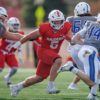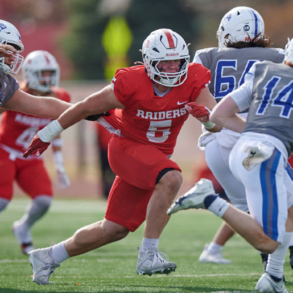Skip to content
Ad Disclosure

This will sound disrespectful, but I don’t intend for it to be the case.
I don’t see a bunch of elite running backs returning to the SEC. Again.
Last year, the SEC returned just 1 of its top 8 leading rushers. This year, the SEC will return 3 of its 8 leading rushers, but 1 of those guys (Le’Veon Moss) is coming off a torn ACL and another is a quarterback (Diego Pavia). Go figure that the lone returning running back in that group who is healthy is Tre Wisner, who was considered Texas’ 3rd-string running back heading into fall camp last year, but a season-ending injury to potential breakout star CJ Baxter helped him rise into a more prominent role.
At this time last year, Baxter was the guy that I predicted to be the conference’s leading rusher. Steve Sarkisian‘s background with developing elite, workhorse backs in the 2020s had a lot to do with that, as did Baxter exceeding 100 scrimmage yards in a College Football Playoff game as a true freshman in 2023.
If you’re trying to project a leading rusher in the SEC this year, where would you start? If Baxter returns and is in a timeshare with Wisner, the answer might not be in Austin, and the same could be true for Moss, who suffered that torn ACL on a brutal hit to the knee against South Carolina.
Again, I ask, where are the elite returning backs in the SEC?
Don’t get it twisted. There are good, solid players who could end up being the 2025 version of Dylan Sampson, who bucked all sorts of workload trends in a Josh Heupel backfield and basically locked up the SEC rushing title by late October (Sampson wasn’t my pick to lead the SEC in rushing but I did have him on my official All-Bang The Drum Team last summer).
Jadan Baugh could be that guy behind an experienced offensive line at Florida. Fellow second-year guy Nate Frazier impressed a lot of folks as a true freshman (he’s also the SEC running back with the best Heisman Trophy odds at a distant 120-to-1) while Trevor Etienne dealt with injuries, and LSU fans were clamoring for Caden Durham to get more touches after he also rose in the backfield hierarchy in Year 1.
But tell me this: outside of the aforementioned Wisner and Moss, how many returning SEC backs hit even 1 of these numbers in 2024?
- 800 rushing yards
- 9 rushing touchdowns
- 5.4 yards/carry (min. 100 carries)
- 65 rushing yards/game
Nobody else checked a single one of those boxes in 2024. At least not in the SEC.
I hear you, Mizzou fans. You’re screaming at me “bring up Ahmad Hardy!” Take a deep breath. At Louisiana-Monroe, Hardy was No. 12 in FBS with 1,351 rushing yards. If he becomes the next Eli Drinkwitz back to lead the SEC in rushing, nobody will be surprised. A 1-year comet at Mizzou is always in the cards.
It is, however, feeling like a dying breed. The multi-year, elite SEC running back has been harder to come by than some might realize. I went back and found the number of the SEC’s 1,000-yard rushers (only RBs) that returned each year of the Playoff era:
- 2014 — 3
- 2015 — 5
- 2016 — 4
- 2017 — 7
- 2018 — 3
- 2019 — 3
- 2020 — 3
- 2021 — 2*
- 2022 — 2
- 2023 — 3
- 2024 — 0
- 2025 — 1
*returned after shortened COVID season
That includes when the 2023 season began with Rocket Sanders and Quinshon Judkins as the SEC’s first instance of multiple 1,400-yard rushers returning. Then 2023 finished with what turned about to be a lost season for Sanders, who hit the portal at season’s end while it was a good, not great year from Judkins … that also concluded with him hitting the transfer portal for Ohio State.
The portal could be one of the answers to this question. Not only does that relate to running back being considered a more replaceable position than skill-player spots like receiver or quarterback, but is there also increased motivation to share the wealth? That’s possible. The season has never been longer, and if there’s a fear that a 2nd-string running back is going to bounce if he doesn’t get 10 touches per game, that takes away from a potential 200-carry back emerging. Plus, as my guy Cole Cubelic pointed out, there have definitely been instances of SEC coaches trying to appease target-hungry receivers in hopes that they don’t hit the portal.
But let’s not do the thing where the portal is entirely to blame for an issue. It’s one of several answers to this question. The portal, the Playoff, the play-calling in an era when it’s more pass-friendly than ever, etc. Those are macro culprits for the lack of elite returning backs. The mirco culprits could be that a team like Ole Miss struggled in atypical fashion to find a go-to back, while prolific running teams like Arkansas and Mizzou opted for 1-year portal options for their lead backs.
Ah, I blamed the portal again. My bad.
Whatever the case, the SEC had just 3 players hit the 1,000-yard mark last season. If we exclude the COVID-shortened 2020 season, it’s the lowest total by the SEC since 2006, which ironically enough, was when the SEC’s run of dominance began. Perhaps there’s something to do that. Alternatively, this is just a valley in an otherwise prolific conference when it comes to producing multi-year backfield standouts.
For all we know, another peak is in store in the latter half of the decade. We shouldn’t rule that out, especially with all of those aforementioned second-year backs like Frazier, Baugh and Durham (I’d include Baxter on that list). A year from now, the discussion could be about where the returning SEC running back class ranks among the all-time great groups like 2015 or 2017.
But in the meantime, we’ll have a unique debate on our hands.
Connor O’Gara is the senior national columnist for Saturday Down South. He’s a member of the Football Writers Association of America. After spending his entire life living in B1G country, he moved to the South in 2015.
You might also like…
This post was originally published on this site be sure to check out more of their content.









